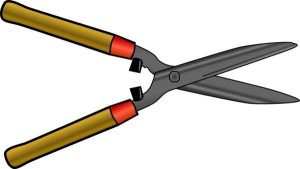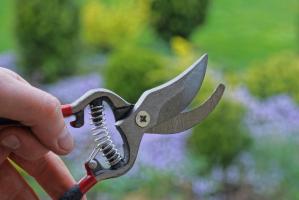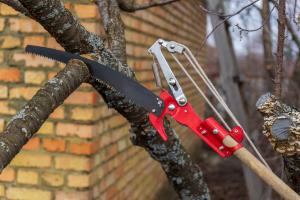Fruit Tree Pruning – Basic Principles

This post is also available in:
This post is also available in:
![]() Ελληνικά (Greek)
Ελληνικά (Greek)
After determining the young tree’s shape with training, the farmer needs to prune it to maintain that shape and balance vegetative growth (renewal of branches) and yield (fruit production). Before starting pruning, it is essential to know from which units your tree crop is going to produce next year’s yield.
Pruning aims to improve the quality, productivity and strength of a tree/plant while it accelerates the harvesting procedure. It is mainly done during the winter, commonly called as dormant or winter pruning. Dormant pruning influences mainly the interactions that will be established in the following season.
However, there are also summer prunings, which focus on eliminating the already existing interactions of shoots/roots/fruits. The most used pruning approach, though, is still a combination of shoot and limb thinning, while the intensity and period of pruning depend on the soil, climate and management conditions.
Dormant or Winter Pruning
During planting, especially in fruit and nut trees, it is necessary to prune in order to balance the above-the-ground (plant canopy) with the below plant parts (root system) and the vegetative growth (shoot growth) with the reproduction (flower and fruit growth). Additionally, it will help the farmer to maintain the height and shape of the trees based on the training system applied and it will facilitate the same time cultivation practices like harvesting. In fruit trees that are “safer” from the phenomenon of alternate bearing, growers can use pruning to balance the production load between the years by applying light pruning during the years of large production and heavier pruning during the off-years. It’s better to prune when all danger, from late winter or early spring frost, has passed but before the blooming period. Moreover, no pruning should be performed when the weather is wet or/and rainy, ideally before bud break and two weeks after the last frost. Keep in mind that in some cases, you may need to adjust the frequency and intensity of pruning depending on the tree species, their age, performance, production load, market standards, etc.
Mature, old, or damaged trees/plants may need heavy pruning if they have shown little or decreased growth or they have extensive damage from natural phenomena or pest and pathogen infections. This will decrease the problem and promote rejuvenation. Of course, some tree species react better at heavy pruning than others. You are advised to consult an agronomist before performing such prunings.
Summer Prunings
Depending on the tree species, the year and the direction of the production (market), there are different types of summer pruning that a farmer may apply. Generally, summer pruning should be limited to removing water sprouts and suckers (Suckering). So, to minimize the possibility of winter damage due to early sprouting, summer pruning should be avoided after the end of July (in the North hemisphere). However, sweet cherry trees, for example, may be pruned in August when there’s less risk for bacterial infection. In many cases, farmers may need to lightly prune their trees to remove broken, damaged, dead or infested-infected shoots even later in the season (spring or summer).
Another significant action is thinning out and heading back. Thinning out results in flexible and long limbs that bend down when loaded with fruit, while heading back makes limbs branch laterally and stiffen. Light heading at young trees promotes branching and you will notice that the headed branch is much stronger, resulting in lateral secondary branching.
In a mature tree, you should focus on thinning out more of the shoots that grow toward the end of a well-pruned branch. As a result, there will be development in fruit size and quality on the remaining shoots. If you want to change the height of a tall tree, you can cut limbs at the top to a lateral branch that is the desired height and leave the branch collar but try not to leave stubs. Stubs won’t heal and could cause wood rot. Another important tip is that you should bend limbs to the desired angle because bending will help the plant direct its resources into fruit production instead of shoot growth. Then, you are advised to secure the limbs in place by using weights or tying them with twine. Keep the bent limb in the position you desire for one growing season so that the branch will stiffen and stay at that angle. Be careful in order not to break the branch. The received benefits will be many more if the limb is thicker and more upright.
In some crops like grape vines, defoliation may be needed to applied. This practice includes manually removing several leaves to improve aeration and sunlight penetration in the center of the canopy and facilitate the penetration of phytochemicals sprayed for plant protection.
Fruit thinning is usually required in many fruit trees to obtain fruits of superior quality and larger size. At the same time, it reduces the risk of limb breakage (due to excessive fruit load) and stimulates flower initiation for next year’s production. This practice must be performed in years when the environmental conditions have favored excessive fruit sets and is more commonly needed in specific tree species than in others. In some fruit trees, like peaches, farmers can perform fruit thinning with spring pruning, removing some fruiting lateral shoots. This technique is not recommended in a region with late spring frosts. Fruit thinning can also be performed when the fruits start forming by removing part of them to allow the plant to redirect its resources to the rest, fewer fruits succeeding better quality. This practice is very common in table olive trees, sweet cherries, apricots, etc.
Pruning Tools
Suitable equipment for pruning is a vital part of the process. You should ensure the tools are of the highest quality possible and in good condition (clean, lubricated, disinfected) to have the best results.
You can see some of these tools below, such as long-handled pruning shear (Figure 1), which could be the most useful tool for pruning and is designed for straight cuts. Also, hand pruners (Figure 2) are used mainly for young trees and can be divided into an anvil and by-pass pruners. The straight blade of anvil pruners closes against a small block or anvil as the handles are squeezed, while the carved blade of by-pass pruners slides past a wider blade. By-pass pruners have a curved blade that slides past a broader blade. By-pass pruners reduce the damage of tissues, whereas anvil pruners are not so safe. If you want to make a large, deep cut, you should use pole saws (Figure 3), which can sometimes be combined with pole pruners.

Figure 1. Pruning shear


Figure 2. Hand shears

Figure 3. Pole saw
References:
https://treefruit.wsu.edu/orchard-management/pruning-and-training-systems/
https://www.uky.edu/Ag/Horticulture/QRLabels/Pruning.html
https://www.davuniversity.org/images/files/study-material/Training%20and%20pruning.pdf
https://extension.purdue.edu/county/vigo/_docs/Training-and-Pruning-Fruit-Trees.pdf
https://extension.okstate.edu/fact-sheets/training-young-shade-and-ornamental-trees.html
https://www.extension.purdue.edu/extmedia/ho/ho-4-w.pdf
http://ecoursesonline.iasri.res.in/mod/page/view.php?id=1588
https://extension.oregonstate.edu/pub/pnw-400
https://extension.psu.edu/pruning-flowering-shrubs
https://www.actahort.org/books/1084/1084_60.htm
https://www.actahort.org/books/322/322_26.htm
https://hortnews.extension.iastate.edu/guide-pruning-equipment








































































